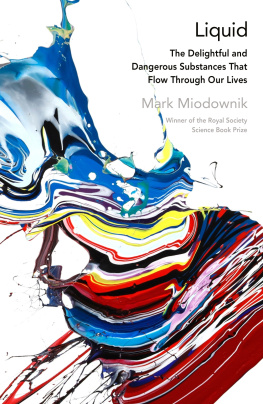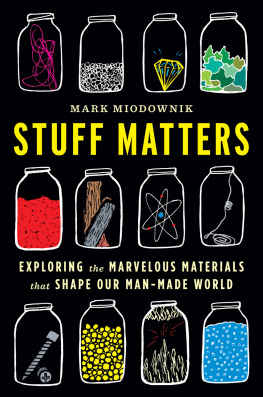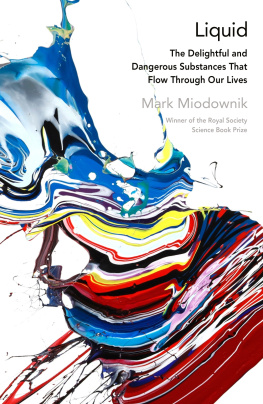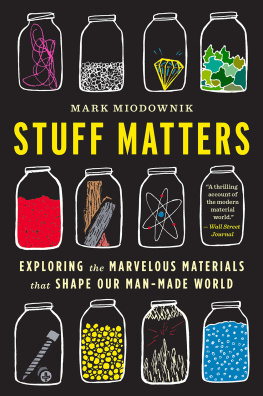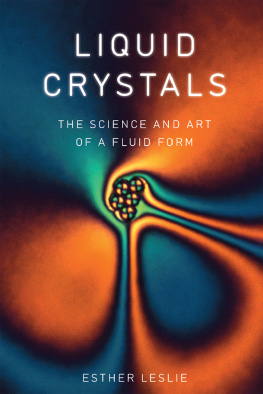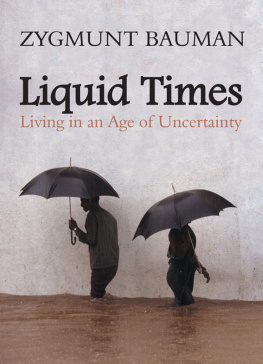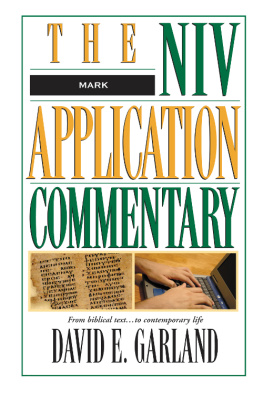Mark Miodownik - Liquid: The Delightful and Dangerous Substances That Flow Through Our Lives
Here you can read online Mark Miodownik - Liquid: The Delightful and Dangerous Substances That Flow Through Our Lives full text of the book (entire story) in english for free. Download pdf and epub, get meaning, cover and reviews about this ebook. year: 2018, publisher: Viking, genre: Science. Description of the work, (preface) as well as reviews are available. Best literature library LitArk.com created for fans of good reading and offers a wide selection of genres:
Romance novel
Science fiction
Adventure
Detective
Science
History
Home and family
Prose
Art
Politics
Computer
Non-fiction
Religion
Business
Children
Humor
Choose a favorite category and find really read worthwhile books. Enjoy immersion in the world of imagination, feel the emotions of the characters or learn something new for yourself, make an fascinating discovery.
- Book:Liquid: The Delightful and Dangerous Substances That Flow Through Our Lives
- Author:
- Publisher:Viking
- Genre:
- Year:2018
- Rating:3 / 5
- Favourites:Add to favourites
- Your mark:
- 60
- 1
- 2
- 3
- 4
- 5
Liquid: The Delightful and Dangerous Substances That Flow Through Our Lives: summary, description and annotation
We offer to read an annotation, description, summary or preface (depends on what the author of the book "Liquid: The Delightful and Dangerous Substances That Flow Through Our Lives" wrote himself). If you haven't found the necessary information about the book — write in the comments, we will try to find it.
Mark Miodownik: author's other books
Who wrote Liquid: The Delightful and Dangerous Substances That Flow Through Our Lives? Find out the surname, the name of the author of the book and a list of all author's works by series.
Liquid: The Delightful and Dangerous Substances That Flow Through Our Lives — read online for free the complete book (whole text) full work
Below is the text of the book, divided by pages. System saving the place of the last page read, allows you to conveniently read the book "Liquid: The Delightful and Dangerous Substances That Flow Through Our Lives" online for free, without having to search again every time where you left off. Put a bookmark, and you can go to the page where you finished reading at any time.
Font size:
Interval:
Bookmark:
Stuff Matters

UK | USA | Canada | Ireland | Australia
India | New Zealand | South Africa
Viking is part of the Penguin Random House group of companies whose addresses can be found at global.penguinrandomhouse.com.

First published 2018
Copyright Mark Miodownik, 2018
The moral right of the author has been asserted
Cover image: Katrin Fridriks, Noble & Awakening Force, 2016 (detail), 130 x 150 x 5cm Photo Fridriks workshop - Cedric Pierre, 2016
ISBN: 978-0-241-97731-6
In loving memory of my mum and dad
I have had peanut butter, honey, pesto sauce, toothpaste and, most painfully, a bottle of single-malt whisky all confiscated at airport security. I inevitably lose the plot in situations like this. I say things like I want to see your supervisor, or peanut butter is not a liquid, even though I know it is. Peanut butter flows and assumes the shape of its container that is what liquids do and so peanut butter is one. Even so, it just infuriates me that in a world full of smart technology airport security still cant tell the difference between a liquid spread and a liquid explosive.
Although bringing more than 100 ml of liquid through security has been banned since 2006, our detection technology has not improved much in that time. X-ray machines can see through your luggage to detect objects. In particular they alert security to suspicious shapes: distinguishing guns from hairdryers, and knives from pens. But liquids dont have a shape. They just take the form of whatever is containing them. Airport scanning technology can also detect density and a range of chemical elements. But here again they run into problems. The molecular make-up of the explosive nitroglycerine, for instance, is similar to peanut butters. Theyre both made from carbon, hydrogen, nitrogen and oxygen and yet one is a liquid explosive while the other is just, well, delicious. There are an enormous number of dangerous toxins, poisons, bleaches and pathogens that are incredibly difficult to distinguish from more innocent liquids in a quick and reliable manner. And it is this line of argument, which Ive heard from many security guards (and their supervisors), that usually persuades me to agree begrudgingly that my peanut butter, or one of the other liquids I seem to regularly forget to take out of my carry-on luggage, is a significant risk.
Liquids are the alter ego of dependable solid stuff. While solid materials are humanitys faithful friend, taking on the permanent shapes of clothes, shoes, phones, cars and indeed airports, liquids are fluid; they will take on any shape, but only while contained. When theyre not contained, they are always on the move, seeping, corroding, dripping and escaping our control. If you put a solid material somewhere it stays there barring forcible removal often doing something very useful, like holding up a building or supplying electricity for a whole community. Liquids, on the other hand, are anarchic: they have a knack of destroying things. In a bathroom, for instance, it is a constant battle to keep water from seeping into cracks and pooling under the floor, where it gets up to no good, rotting and undermining the wooden joists; on a smooth tile floor, water is the perfect slip hazard, causing an enormous number of injuries; and when it gathers in the corners of the bathroom, it can harbour black slimey fungus and bacteria, which threaten to infiltrate our bodies and make us sick. And yet, despite all this treachery, we love the stuff; we love bathing in water, and showering in it, drenching our whole body. And what bathroom is complete without a cornucopia of bottled liquid soaps, shampoos and conditioners, jars of cream and tubes of toothpaste? We delight in these miraculous liquids and yet we worry about them too: are they bad for us? Do they cause cancer? Do they ruin the environment? With liquids, delight and suspicion go hand in hand. They are duplicitous by nature, neither a gas nor a solid but something in-between, something inscrutable and mysterious.
Take mercury, for instance, which has delighted and poisoned humanity for thousands of years. As a child I used to play with liquid mercury, flicking it around table tops, fascinated by its otherworldliness, until I was made aware of its toxicity. But in many ancient cultures mercury was thought to prolong life, heal fractures and maintain good health. Its not clear why it was held in such regard perhaps because it is special in being the only pure metal that is liquid at room temperature. The first emperor of China, Qin Shi Huang, took mercury pills for his health but died at thirty-nine, probably as a result. Even so, he was buried in a tomb full of rivers of flowing mercury. The Ancient Greeks used mercury in ointments, and alchemists believed that a combination of mercury and another elemental substance, sulphur, formed the basis of all metals a perfect balance between mercury and sulphur creating gold. This was the origin of the erroneous belief that different metals could be transmuted into gold if mixed in the right proportions. While that proved to be the stuff of legend, gold does dissolve in mercury. If you heat up that liquid once it has absorbed the metal, it will evaporate, leaving behind a solid lump of gold. For most ancient people that process was indistinguishable from magic.
Mercury isnt the only liquid that can consume another substance and contain it within itself. Add salt to water and it will soon disappear the salt is somewhere but where has it gone? Yet if you do the same with oil, the salt just sits there. Why? Liquid mercury may absorb solid gold, but it rejects water. Why is that? Water absorbs gases, including oxygen, and if it didnt, we would live in a very different world it is the oxygen dissolved in water that allows fish to breathe. And although water cant carry enough oxygen for humans to breathe, other liquids can. Theres a type of oil perfluorocarbon liquid that is very unreactive chemically and electrically. It is so inert that you can put your mobile phone in a beaker of perfluorocarbon liquid and it will continue to operate normally. Perfluorocarbon liquid can also absorb oxygen in such high concentrations that it is breathable by humans. This sort of liquid-breathing breathing liquid instead of air has many possible uses, the most important of which is to treat premature babies suffering from respiratory-distress syndrome.
Still, it is liquid water that has the ultimate life-giving property. This is because it can dissolve not just oxygen, but many other chemicals too, including carbon-based molecules, and so provides the aqueous environment required for the emergence of life for new organisms to spontaneously come into existence. Or, at least, that is the theory. And it is why, when scientists look for life on other planets, they look for liquid water. But liquid water is rare in the universe. Its possible that Europa, one of the moons of Jupiter, might have oceans of liquid water below its icy crust. There might also be liquid water on Enceladus, one of the moons of Saturn. But Earth is the only body in the Solar System where a lot of water is readily available on its surface.
A peculiar set of circumstances on our planet has made possible the surface temperatures and pressures that can sustain liquid water. In particular, if it werent for the Earths molten-metal liquid core, which creates the magnetic field that protects us from the solar wind, all our water would most likely have disappeared billions of years ago. In short, on our planet, liquid begat liquid, and that led to life.
Font size:
Interval:
Bookmark:
Similar books «Liquid: The Delightful and Dangerous Substances That Flow Through Our Lives»
Look at similar books to Liquid: The Delightful and Dangerous Substances That Flow Through Our Lives. We have selected literature similar in name and meaning in the hope of providing readers with more options to find new, interesting, not yet read works.
Discussion, reviews of the book Liquid: The Delightful and Dangerous Substances That Flow Through Our Lives and just readers' own opinions. Leave your comments, write what you think about the work, its meaning or the main characters. Specify what exactly you liked and what you didn't like, and why you think so.

